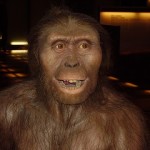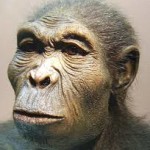
Australopithecus
Dear Dr. Collins,
I’d like to begin by saying that I have tremendous respect for your work on the Human Genome Project. I enjoyed your book The Language of God so much that even quoted you a couple of times in my book, Counterargument for God.
So, if there is a human being on planet Earth as qualified to answer my question as (atheist) biologist Jerry Coyne, it would appear to be either you, or (Catholic) biology professor Ken Miller, whose work I’m most familiar with from watching his lectures posted on You Tube that attack intelligent design. However, I did appreciate his calm and pleasant demeanor on display while he ridiculed my personal beliefs.

One thing that you and Professor Miller seem to share in common with Professor Coyne is your apparent belief in the infallibility of evolution theory, and that descent is the only viable explanation for the origin of species.
Unsurprisingly, Professor Coyne didn’t respond to his open letter. However, I didn’t really try to hide the fact that I am a creationist and an advocate of intelligent design. Professor Coyne may have been hostile to the source, rather than the questions asked. In retrospect, I probably could have done a better job of framing my questions without antagonizing him.
Professor Benoit LeBlanc was kind enough to attempt answering them, but unfortunately his answer required Deep Time that I don’t believe is available in the scenario we’re hopefully about to discuss.
I don’t believe my personal religious beliefs will keep either of you gentlemen from answering my questions because we are all professed Christians. I’m merely asking you to help a brother understand why design is stupid and unscientific and how common descent makes perfect sense, even to describe the relationship between plants and animals.
Before going any further, please let me assure you that my only interest is in finding the best possible and most comprehensible answers to my own existential questions. These aren’t trick questions — I really want to know the answers, assuming they can be answered. I will be very pleased to publish responses from either of you gentlemen as a separate post, in its entirety.
I sincerely seek truth — if the truth turns out to be descent and not design, so be it. Quid est veritas?
Design makes sense to me. Descent does not. Humans have 23 pairs of chromosomes, and all apes supposedly have 24 pairs.
As experts in biology, I know you were already quite familiar with that very important fact.
But how exactly did ape-like primates evolve to become human?
Of course, I know that biologists have “widely accepted” the theory two “ancestral” chromosomes fused end-to-end and formed human chromosome 2. Professor Miller even says as much in this video.
My concern specifically revolves around Professor Miller’s use of the word “fusion” to describe this alleged freak accident of nature. Because in every science text I’ve read, fusion typically describes the process when two atoms collide at high speed and bond together.
In this case it would seem that the collision could have only occurred inside the first atom formed at the moment of conception, then replicated in every additional cell formed in this new organism — sort of a chain reaction. After all, fusion is an instantaneous process.
Surely your argument isn’t that two ancestral chromosomes “gradually” fused into one single chromosome over thousands, or even millions of years, is it?
In the video link provided above, Professor Miller said the chromosome missing in humans could not have ever been lost without causing fatality in the offspring.
Therefore, if fusion is truly the only means by which this new human chromosome 2 could have formed (as Professor Miller suggested) then Goldschmidt’s hopeful monster theory would seem to best describe the ape-to-human evolutionary process, wouldn’t it? And if that is so, the mating problem of the hopeful monster is reintroduced into our discussion, correct?
If Australopithecus had 24 chromosomes, then it was some sort of an ape. If Homo Habilis had 23 chromosomes, it was human. If Australopithecus evolved into Homo Habilis by fusing two chromosomes into one, it would only seem possible if it occurred within one single generation.

Homo Habilis
If the parents of Adam (the first human with 23 chromosomes) had 24 chromosomes, then Adam was not even biologically compatible with his own parents. Therefore, Adam could only have mated with another lucky product of fusion, a female “Eve.”
Eve would have had to be born within Adam’s lifespan and within close enough proximity for them to meet and of course, reproduce to create viable offspring that perpetuated the new species. That would seem to make descent twice as unlikely than if it only needed to happen for Adam within a single generation.
Are biologists wrong to use the word “fusion” to describe the formation of human chromosome 2? Is there any possible way that the forming of this particular chromosome could have taken a very long period of time?
Inquiring minds would like to know…

[…] author John Leonard penned an open letter to geneticists Dr. Francis Collins and Dr. Kenneth Miller, found here. Dr. Miller kindly responded to Leonard’s letter and Leonard posted it on his blog yesterday. […]